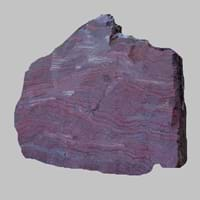Definition
Banded iron formation are distinctive units of sedimentary rock that are almost always of Precambrian age
Siltstone can be defined as a fine-grained sedimentary rock which mainly consists of consolidated silt
Origin
Western Australia, Minnesota
Unknown
Discoverer
Unknown
Unknown
Etymology
From its formation process
From English word silt and stone and from Proto-Indo-European root sal and stainaz
Class
Sedimentary Rocks
Sedimentary Rocks
Sub-Class
Durable Rock, Medium Hardness Rock
Durable Rock, Hard Rock
Group
Not Applicable
Not Applicable
Other Categories
Coarse Grained Rock, Opaque Rock
Fine Grained Rock, Opaque Rock
Texture
Banded, Trellis
Clastic
Color
Red, Reddish Brown
Brown, Red, Reddish Brown
Durability
Durable
Durable
Scratch Resistant
Yes
Yes
Appearance
Layered, Banded, Veined and Shiny
Rough
Interior Uses
Decorative Aggregates, Homes
Decorative Aggregates, Interior Decoration
Exterior Uses
Paving Stone, Office Buildings
As Building Stone, As Facing Stone, Garden Decoration
Other Architectural Uses
Curbing, Whetstones
Curbing
Construction Industry
As Dimension Stone, Used for flooring, stair treads, borders and window sills.
Building houses or walls, Cement Manufacture, Construction Aggregate, for Road Aggregate, Making natural cement, Raw material for the manufacture of mortar
Medical Industry
Not Yet Used
Not Yet Used
Antiquity Uses
Artifacts
Artifacts, Sculpture, Small Figurines
Commercial Uses
As a touchstone, Cemetery Markers, Creating Artwork
Raw material for the manufacture of mortar, Soil Conditioner
Types
Algoma-type , Lake Superior-type, Superior-type and Taconite
Not Available
Features
Is one of the oldest rock
Available in Lots of Colors and Patterns, Easily splits into thin plates, Generally rough to touch, High silica content, Very fine grained rock
Archaeological Significance
Monuments
Not Yet Used
Not Yet Used
Famous Monuments
Not Applicable
Not Applicable
Sculpture
Not Yet Used
Used
Famous Sculptures
Not Applicable
Data Not Available
Pictographs
Not Used
Not Used
Petroglyphs
Not Used
Not Used
Figurines
Not Yet Used
Used
Formation
The banded iron layers are formed in sea water when oxygen is released by photosynthetic cyano-bacteria. The oxygen then combines with dissolved iron in ocean to form insoluble iron oxides, which precipitated out, forming a thin layer of banded iron formation on ocean floor.
Siltstone is a type of sedimentary rock which is formed from fine rock particles. As the particles of eroded rock travel along with water, the edges of the rock are worn-out by water into a rounded shape.
Mineral Content
Hematite, Magnetite, Quartz
Calcite, Clay, Clay Minerals, Feldspar, Micas, Quartz, Sand, Silica, Silt
Compound Content
Fe, Iron(III) Oxide, Silicon Dioxide
Aluminium Oxide, CaO, Iron(III) Oxide, Potassium Oxide, MgO, Sodium Oxide, Silicon Dioxide
Types of Metamorphism
Not Applicable
Not Applicable
Types of Weathering
Chemical Weathering
Biological Weathering, Chemical Weathering, Mechanical Weathering
Types of Erosion
Coastal Erosion, Wind Erosion
Chemical Erosion, Coastal Erosion, Glacier Erosion
Grain Size
Large and Coarse Grained
Fine Grained
Fracture
Uneven, Splintery or Conchoidal
Conchoidal
Porosity
Highly Porous
Highly Porous
Cleavage
Imperfect
Not Available
Specific Gravity
5.0-5.3
2.54-2.73
Transparency
Translucent to Opaque
Opaque
Density
Not Available
2.6-2.7 g/cm3
Specific Heat Capacity
Not Available
Resistance
Heat Resistant, Impact Resistant, Pressure Resistant, Wear Resistant
Heat Resistant, Impact Resistant, Pressure Resistant, Water Resistant
Deposits in Eastern Continents
Asia
China, India, Iran, Iraq, Oman, Russia, Saudi Arabia, Taiwan, Thailand, Vietnam
China, India, Kazakhstan, Mongolia, Russia, Uzbekistan
Africa
Kenya, Morocco, South Africa, Tanzania
Namibia, Nigeria, South Africa
Europe
Austria, France, Greece, Italy, Malta, Poland, Portugal, Serbia, Spain, Sweden, United Kingdom
Austria, Denmark, Germany, Great Britain, Netherlands, Norway, Poland, Sweden, Switzerland, United Kingdom
Others
Greenland, Mid-Atlantic Ridge
Greenland
Deposits in Western Continents
North America
Canada, Mexico, USA
Canada, USA
South America
Bolivia, Brazil
Brazil
Deposits in Oceania Continent
Australia
New South Wales, Queensland, South Australia, Western Australia
New South Wales, New Zealand










